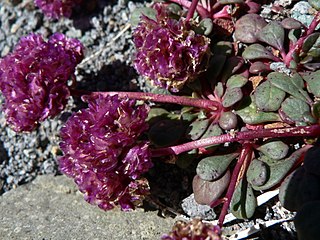
Cistanthe is a plant genus which includes most plants known as pussypaws. These are small, succulent flowering plants which often bear brightly colored flowers, though they vary quite a bit between species in appearance. Some species have flowers that are tightly packed into fluffy-looking inflorescences, the trait that gives them their common name. Many are adapted to arid environments, with some able to withstand climates that almost completely lack rainfall. Cistanthe was a genus created to segregate several species previously classified in Calandrinia. Several species from other closely related genera have been moved into Cistanthe as well.
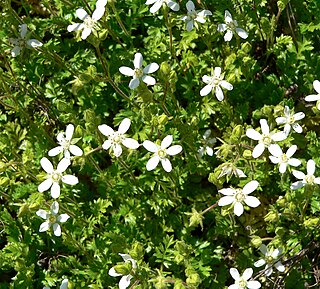
Horkelia parryi is a species of flowering plant in the rose family known by the common name Parry's horkelia. It is endemic to California, where it grows in the chaparral of the Sierra Nevada foothills. This is a low, mat-forming perennial herb growing in unobtrusive green patches on the ground. The leaves are 5 to 10 centimeters long and are each made up of small, toothed, oval-shaped leaflets. The somewhat hairy green to reddish-green stems are 10 to 30 centimeters long and bear inflorescences of a few flowers each. The flower has minute bractlets under larger, pointed sepals and five white petals. The center of the flower contains a ring of stamens around a patch of up to 50 thready pistils.

Jepsonia parryi is an uncommon species of flowering plant in the saxifrage family known by the common names coast jepsonia and Parry's jepsonia.
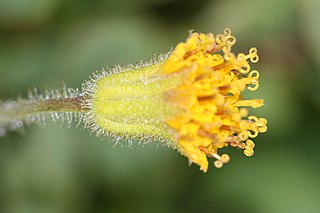
Arnica parryi is a North American species of arnica known by the common name Parry's arnica or nodding arnica. It is native to western Canada and the western United States as far south as Inyo County, California and McKinley County, New Mexico. It grows in temperate coniferous forests and alpine meadows in mountainous areas, primarily the Rocky Mountains, Cascades, and Sierra Nevada.

Chorizanthe parryi is a species of flowering plant in the buckwheat family known by the common name Parry's spineflower and San Bernardino spineflower.
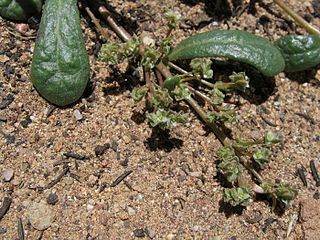
Calyptridium monandrum, synonym Cistanthe monandra, is a species of flowering plant in the family Montiaceae known by the common name common pussypaws.
Allium parryi is a North American species of wild onion known by the common names Parry's onion and Parry's fringed onion. It is common in the Coast Ranges of southern California and northern Baja California. It is also known from the southernmost reaches of the Sierra Nevada.

Calyptridium monospermum, synonym Cistanthe monosperma, is a perennial plant in the miner's lettuce family (Montiaceae), known by the common name one-seeded pussypaws. It was formerly classified in the purslane family (Portulacaceae).
Calyptridium pulchellum, synonym Cistanthe pulchella, is a rare species of flowering plant in the family Montiaceae. It is known by the common name mariposa pussypaws. It is endemic to the Sierra Nevada foothills of central California, where it is known from only a few scattered occurrences. It grows on barren patches of granite gravel in woodland and grasslands. It is a federally listed threatened species.
Calyptridium quadripetalum, synonym Cistanthe quadripetala, is a species of flowering plant in the family Montiaceae. It is known by the common name four-petalled pussypaws. It is endemic to the North Coast Ranges of California, where it is an uncommon member of the serpentine soils flora on the slopes. It is a small annual plant spreading or erect stems each a few centimeters long. There is a basal rosette of small, thick leaves and a few along the stems. The inflorescence is a dense cluster of sepals and four white to pink round petals.

Calyptridium roseum, synonym Cistanthe rosea, is a species of flowering plant in the family Montiaceae commonly known as rosy pussypaws. It is native to the western United States from California to Wyoming, where it grows in forest and scrub. It is an annual herb, often reddish or pink in color, producing stems just a few centimeters long. The leaves are located in a rosette at the base and along the stems, and are up to 4 or 5 centimeters long. The inflorescence is a tiny cluster of white-edged thin sepals and two white petals, each no more than a millimeter long.

Calyptridium umbellatum, synonym Cistanthe umbellata, is a species of flowering plant in the montia family known by the common name Mount Hood pussypaws or — especially outside the Pacific Northwest — simply pussy-paws.
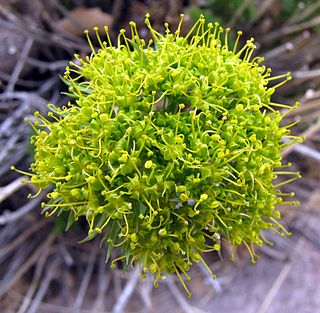
Lomatium parryi, commonly known as Parry's biscuitroot and Utah desertparsley, is a perennial herb in the carrot family. It is a common herb in high altitude areas of deserts and common in desert National parks, such as Death Valley mountains, in the western part of the United States.

Marina parryi is a species of flowering plant in the legume family known by the common name Parry's false prairie-clover. It is native to the deserts of the southwestern United States and northern Mexico. This is a perennial herb producing stiff, branching stems 20 to 80 centimeters long. It is coated with glands and rough hairs. The leaves are made up of several pairs of small oval leaflets no more than 6 millimeters long. The inflorescence is a raceme of deep blue and white bicolored flowers each under a centimeter long. The fruit is a legume pod containing a single seed.

Mesembryanthemum nodiflorum is a species of succulent plant in the genus Mesembryanthemum known by the common name slenderleaf iceplant. It is the type species for the genus. It is native to Israel, Palestine, and Jordan, as also endemic to southern Africa. It is also native to Croatia on the island of Palagruza in the Adriatic Sea, which is its northernmost habitat, but it is known in many other places as an introduced species and sometimes an invasive weed, including several regions of Australia, parts of the western United States and adjacent Mexico, and some Atlantic islands.
Polygonum parryi is a species of flowering plant in the knotweed family known by the common names Parry's knotweed and prickly knotweed. It is native to the western United States from Washington to California, where it grows in several types of moist, open habitat in mountainous and coastal areas.
Stephanomeria parryi is a species of flowering plant in the aster family known by the common name Parry's wirelettuce. It is native to the southwestern United States, where it grows in many types of habitat, including many desert areas. It is a perennial herb growing from a thick root and producing one or more slender, upright stems up to about 40 centimeters tall. The green leaves are linear to lance-shaped with lobed edges and are up to 8 centimeters long near the base of the plant. Flower heads occur on the spreading branches. Each has up to 13 or 14 ray florets, each with an elongated tube and a whitish ligule up to 1.5 centimeters long. The fruit is an achene tipped with a spreading cluster of long, tan, plumelike pappus bristles.
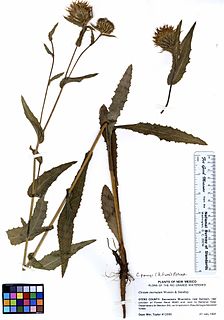
Cirsium parryi, or Parry's thistle, is a species of North American flowering plants in the aster family. It is native to the southwestern United States, where it has been found in Colorado, Arizona, and New Mexico.
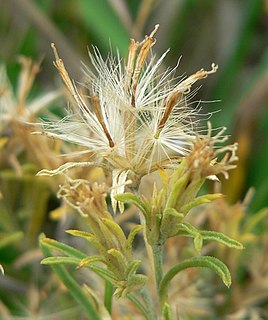
Ericameria parryi is a species of flowering plant in the aster family known by the common name Parry's rabbitbrush. It is native to much of the western United States.

Calyptridium is a genus of flowering plants belonging to the family Montiaceae.














